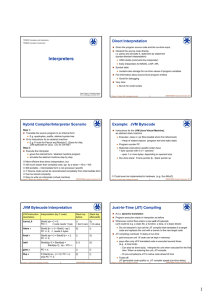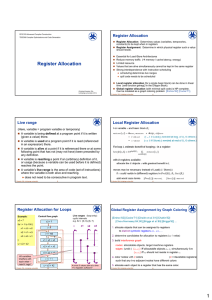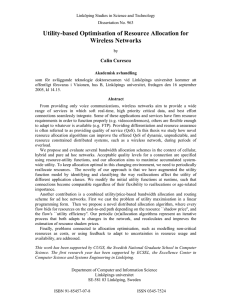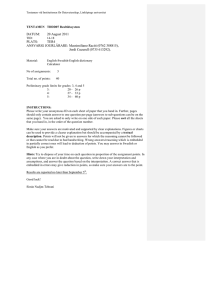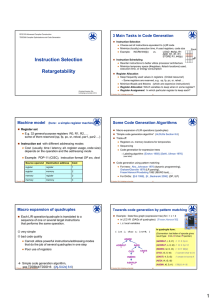Document 13134058
advertisement
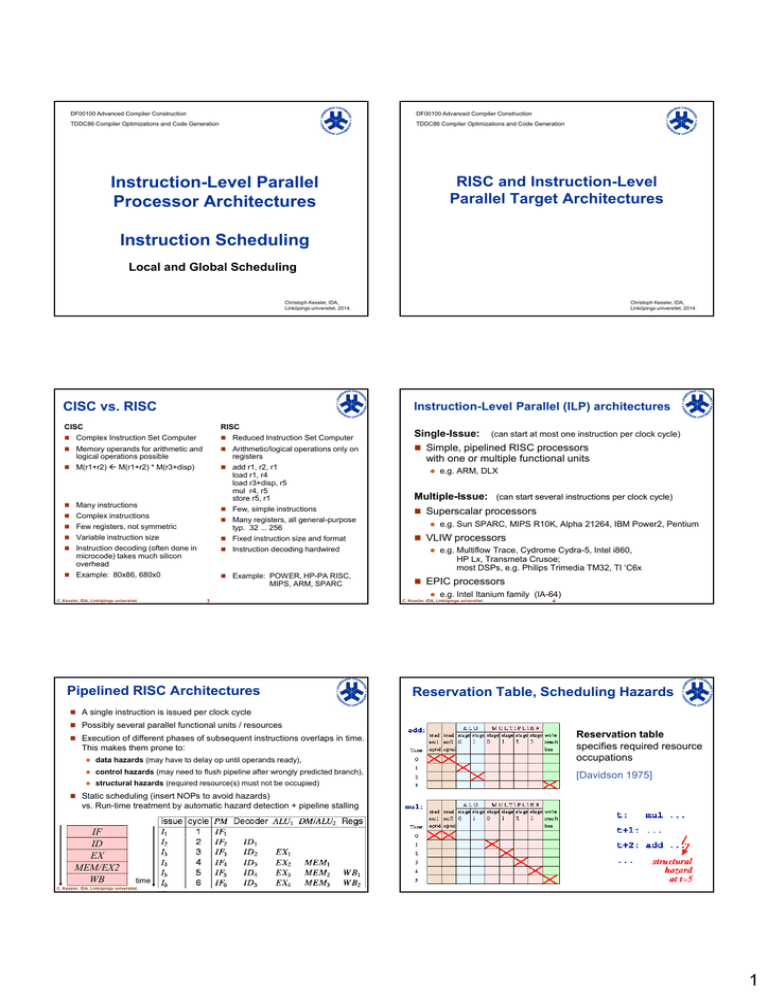
DF00100 Advanced Compiler Construction
DF00100 Advanced Compiler Construction
TDDC86 Compiler Optimizations and Code Generation
TDDC86 Compiler Optimizations and Code Generation
Instruction-Level Parallel
Processor Architectures
RISC and Instruction-Level
Parallel Target Architectures
Instruction Scheduling
Local and Global Scheduling
Christoph Kessler, IDA,
Linköpings universitet, 2014.
CISC vs. RISC
Christoph Kessler, IDA,
Linköpings universitet, 2014.
Instruction-Level Parallel (ILP) architectures
CISC
Complex Instruction Set Computer
Memory operands for arithmetic and
logical operations possible
M(r1+r2) M(r1+r2) * M(r3+disp)
RISC
Reduced Instruction Set Computer
Arithmetic/logical operations only on
registers
add r1, r2, r1
load r1, r4
load r3+disp, r5
mul r4, r5
store r5, r1
Few, simple instructions
Many registers, all general-purpose
typ. 32 ... 256
Fixed instruction size and format
Instruction decoding hardwired
Many instructions
Complex instructions
Few registers, not symmetric
Variable instruction size
Instruction decoding (often done in
microcode) takes much silicon
overhead
Example: 80x86, 680x0
Example: POWER, HP-PA RISC,
MIPS, ARM, SPARC
Single-Issue: (can start at most one instruction per clock cycle)
Simple, pipelined RISC processors
with one or multiple functional units
Multiple-Issue: (can start several instructions per clock cycle)
Superscalar processors
3
TDDC86 Compiler Optimizations and Code Generation
Pipelined RISC Architectures
e.g. Sun SPARC, MIPS R10K, Alpha 21264, IBM Power2, Pentium
VLIW processors
e.g. Multiflow Trace, Cydrome Cydra-5, Intel i860,
HP Lx, Transmeta Crusoe;
most DSPs, e.g. Philips Trimedia TM32, TI ‘C6x
EPIC processors
C. Kessler, IDA, Linköpings universitet.
e.g. ARM, DLX
e.g. Intel Itanium family (IA-64)
C. Kessler, IDA, Linköpings universitet.
4
TDDC86 Compiler Optimizations and Code Generation
Reservation Table, Scheduling Hazards
A single instruction is issued per clock cycle
Possibly several parallel functional units / resources
Reservation table
specifies required resource
occupations
Execution of different phases of subsequent instructions overlaps in time.
This makes them prone to:
data hazards (may have to delay op until operands ready),
control hazards (may need to flush pipeline after wrongly predicted branch),
structural hazards (required resource(s) must not be occupied)
[Davidson 1975]
Static scheduling (insert NOPs to avoid hazards)
vs. Run-time treatment by automatic hazard detection + pipeline stalling
IF
ID
EX
MEM/EX2
WB
time
C. Kessler, IDA, Linköpings universitet.
5
TDDC86 Compiler Optimizations and Code Generation
C. Kessler, IDA, Linköpings universitet.
6
TDDC86 Compiler Optimizations and Code Generation
1
Instruction Scheduling (1)
Instruction Scheduling (2)
Map instructions to time slots on issue units (and resources),
such that no hazards occur
Global reservation table, resource usage map
Data dependences imply latency constraints
target-level data flow graph / data dependence graph
6
latency(mul) = 6 add
C. Kessler, IDA, Linköpings universitet.
7
TDDC86 Compiler Optimizations and Code Generation
mul 6
C. Kessler, IDA, Linköpings universitet.
Superscalar processor
Dual-Issue (w=2)
Run-time scheduling by instruction dispatcher
Example (1):
convenient (sequential instruction stream – as usual)
limited look-ahead buffer to analyze dependences, reorder instr.
high silicon overhead, high energy consumption
8
TDDC86 Compiler Optimizations and Code Generation
Linear code “mul R1,…; add …,R2” expands to
Example: Motorola MC 88110
2-way, in-order issue
superscalar
C. Kessler, IDA, Linköpings universitet.
9
TDDC86 Compiler Optimizations and Code Generation
C. Kessler, IDA, Linköpings universitet.
10
TDDC86 Compiler Optimizations and Code Generation
Dual-Issue (w=2)
VLIW (Very Long Instruction Word) architectures
Example (2):
Multiple slots for instructions in long instruction-word
Linear code “mul R1,…; add …,R1” expands to
Direct control of functional units and resources – low decoding OH
Compiler (or assembler-level programmer)
must determine the schedule statically
independence, unit availability, packing into long instruction words
Challenging! But the compiler has more information on the program
than an on-line scheduler with a limited lookahead window.
Silicon- and
energy-efficient
C. Kessler, IDA, Linköpings universitet.
11
TDDC86 Compiler Optimizations and Code Generation
C. Kessler, IDA, Linköpings universitet.
12
TDDC86 Compiler Optimizations and Code Generation
2
Clustered VLIW processor
EPIC architectures
E.g., TI C62x, C64x DSP processors
Based on VLIW
Register classes
Compiler groups instructions to LIW’s (bundles, fetch units)
Parallel execution constrained by operand residence
Compiler takes care of resource and latency constraints
Compiler marks sequences of independent instructions as
Data bus
Register File A
Register File B
v
u
+
u
u
instruction groups by inserting delimiters (stop bits)
Dynamic scheduler assigns resources and reloads new
bundles as required
v
Unit B1
Unit A1
add.A1 u, v
C. Kessler, IDA, Linköpings universitet.
add.B1 u, v
13
TDDC86 Compiler Optimizations and Code Generation
C. Kessler, IDA, Linköpings universitet.
14
TDDC86 Compiler Optimizations and Code Generation
EPIC Example: Instruction format for TI ’C62x
EPIC Example: Intel IA-64 (Itanium)
Texas Instruments
Constraints on bundle contents and placement of delimiters
DSP processor series
TMS320C62xx
for instruction groups: 24 templates
1 fetch packet (a very long instruction word) has 8 slots
M I
I
M M I
M L
I
M M F
M B B
M M B
M I
I
M M I
M L
I
M M F
M B B
M M B
may contain up to 8 instruction groups (issue packets)
to be executed in sequence
M I
I
M M I
M F
I
M I
B
B B B
M F B
Instruction groups are marked by chaining bits.
M I
I
M M I
M F
I
M I
B
B B B
M F B
Instructions within an instruction group must use disjoint
resources (basically, different functional units)
Up
to 8 instructions in an instruction group
Example: 3 issue groups { A||B||C } ; { D||E||F } ; { G||H }
C. Kessler, IDA, Linköpings universitet.
15
TDDC86 Compiler Optimizations and Code Generation
Example: Local scheduling for IA-64
A DAG with a greedy and an optimal schedule
Instruction types:
Functional units:
M = Memory (on M unit)
I = Integer (on I unit)
F = Floatingpoint (on F unit)
B = Branch (on B unit)
A = supertype of I and M
LX = uses 2 bundle slots, uses I and B units
NOP
can replace
anything, uses no unit
C. Kessler,
IDA, Linköpings
universitet.
16
M
I
B
F
An implementation of the
IA-64 instruction set interface
is the Itanium processor series.
TDDC86 Compiler Optimizations and Code Generation
A Generic ILP-Architecture Model
for Retargetable Code Optimization
Issue width w
M1
M3
w-way in-order superscalar or size of longest instruction group
I2
M4
F6
M5
M1 I2 NOP
M3 M4 NOP
M5 F6 NOP
used templates:
MI;I / MMI; / MFI;
M1 M3 I2
M4 M5 F6
w issue units
f resources
1 … w
1
…
f
functional units, internal buses, …
used templates:
M;MI / MMF;
Instruction set I
for each instruction y in I, specify its
- syntax: mnemonic, parameters, types
- semantics: (tree)pattern in terms of IR operations, latency
- resource requirements: reservation table, issue unit(s)
Formal specification in xADML
Adapted from: S. Haga, R. Barua: EPIC Instruction
Scheduling based on Optimal Approaches.
C. Kessler, IDA, Linköpings universitet.
17
TDDC86 Compiler Optimizations and Code Generation
[Bednarski’06]
(register sets etc. not considered here)
C. Kessler, IDA, Linköpings universitet.
18
TDDC86 Compiler Optimizations and Code Generation
3
DF00100 Advanced Compiler Construction
Instruction Scheduling
TDDC86 Compiler Optimizations and Code Generation
Generic Resource model: Reservation table
Optimize: time, space, energy
Instruction Scheduling
Overview
Local Scheduling
(f. Basic blocks / DAGs)
Data dependences
Topological sorting
List Scheduling (diverse heuristics)
Optimal Scheduling
(Exhaustive search, DP, B&B, CLP, ILP)
Global Scheduling
Code motion, Branch delay slot filling
Trace scheduling, Region scheduling, ...
Cyclic scheduling for loops (Software pipelining)
Christoph Kessler, IDA,
Linköpings universitet, 2014.
DF00100 Advanced Compiler Construction
There exist retargetable schedulers
and scheduler generators, e.g. for GCC since 2003
C. Kessler, IDA, Linköpings universitet.
20
TDDC86 Compiler Optimizations and Code Generation
Optimization problems in local scheduling
TDDC86 Compiler Optimizations and Code Generation
Local Instruction Scheduling
Christoph Kessler, IDA,
Linköpings universitet, 2014.
MRIS: Space-optimal scheduling
C. Kessler, IDA, Linköpings universitet.
22
TDDC86 Compiler Optimizations and Code Generation
Example: Topological Sorting (0)
Given:
Data flow graph of a basic block
(a directed acyclic graph, DAG)
Not yet considered
Data ready (zero-indegree set)
Already scheduled, still alive
Already scheduled, no longer referenced
d
a
C. Kessler, IDA, Linköpings universitet.
23
TDDC86 Compiler Optimizations and Code Generation
C. Kessler, IDA, Linköpings universitet.
24
e
b
c
TDDC86 Compiler Optimizations and Code Generation
4
Example: Topological Sorting (1)
Example: Topological Sorting (2)
Not yet considered
Not yet considered
Data ready (zero-indegree set)
Data ready (zero-indegree set)
Already scheduled, still alive
Already scheduled, still alive
Already scheduled, no longer referenced
Already scheduled, no longer referenced
d
d
e
a
b
a
c
a
C. Kessler, IDA, Linköpings universitet.
25
a
TDDC86 Compiler Optimizations and Code Generation
Example: Topological Sorting (3)
e
C. Kessler, IDA, Linköpings universitet.
26
b
c
b
TDDC86 Compiler Optimizations and Code Generation
Example: Topological Sorting (4)
Not yet considered
Not yet considered
Data ready (zero-indegree set)
Data ready (zero-indegree set)
Already scheduled, still alive
Already scheduled, still alive
Already scheduled, no longer referenced
Already scheduled, no longer referenced
f
d
a
a
C. Kessler, IDA, Linköpings universitet.
27
b
b
d
e
a
c
d
TDDC86 Compiler Optimizations and Code Generation
List scheduling = Topological sorting
b
a b d
C. Kessler, IDA, Linköpings universitet.
28
e
c
and so on...
TDDC86 Compiler Optimizations and Code Generation
Topological Sorting and Scheduling
Construct schedule incrementally
in topological (= causal) order
”Appending” instructions to partial code sequence:
close up in target schedule reservation table
(as in ”Tetris”)
Idea: Find optimal target-schedule by enumerating
all topological sortings ...
Beware of scheduling anomalies
with complex reservation tables!
[K. / Bednarski / Eriksson 2007]
C. Kessler, IDA, Linköpings universitet.
29
TDDC86 Compiler Optimizations and Code Generation
C. Kessler, IDA, Linköpings universitet.
30
TDDC86 Compiler Optimizations and Code Generation
5
Greedy List Scheduling for VLIW (1)
C. Kessler, IDA, Linköpings universitet.
31
TDDC86 Compiler Optimizations and Code Generation
Greedy List Scheduling for VLIW (2)
C. Kessler, IDA, Linköpings universitet.
32
TDDC86 Compiler Optimizations and Code Generation
DF00100 Advanced Compiler Construction
Local Scheduling Heuristics
TDDC86 Compiler Optimizations and Code Generation
List Scheduling Heuristics
Deepest Level First (a.k.a. highest level first etc.)
Select, among ready instructions, one with longest
accumulated latency on a path towards any dependence
sink (root node)
Forward vs Backward scheduling
Global Instruction Scheduling
Critical Path Scheduling
Detect a critical path (longest accumulated latency)
in the DAG, schedule its nodes partial schedule,
and remove them from the DAG.
Repeat until DAG is empty,
splicing in new nodes between scheduled ones as
appropriate, or inserting fresh time slots where needed
C. Kessler, IDA, Linköpings universitet.
33
Christoph Kessler, IDA,
Linköpings universitet, 2014.
TDDC86 Compiler Optimizations and Code Generation
Scheduling Branch Instructions
Remark: Hardware Support
for Branch Delay Slot Filling
Delayed Branch
Effect of conditional branch on program counter is delayed
1 or more instructions after a branch instruction are always executed,
independent of the condition outcome
SPARC, HP PA-RISC: 1 delay slot
TI ’C62x: 5 delay slots
Scheduling: Fill delay slots with useful instruction if there is one,
otherwise with NOP
Heuristic for finding candidate instructions:
1.
Instructions from same basic block that are not control dependent on
the branch and that the condition is not data dependent of
2.
Instructions from most likely branch target basic block for speculative
execution
See e.g. [Muchnick Ch. 17.1.1] for further details
C. Kessler, IDA, Linköpings universitet.
35
TDDC86 Compiler Optimizations and Code Generation
C. Kessler, IDA, Linköpings universitet.
36
TDDC86 Compiler Optimizations and Code Generation
6
Trace Scheduling
C. Kessler, IDA, Linköpings universitet.
Trace Scheduling (2)
37
TDDC86 Compiler Optimizations and Code Generation
C. Kessler, IDA, Linköpings universitet.
38
Trace Scheduling (3)
Trace Scheduling (4)
Insertion of compensation code
Insertion of compensation code
Case: When moving an instruction i2 to a predecessor
block B in the trace T (e.g., to fill a branch delay slot)
C. Kessler, IDA, Linköpings universitet.
39
TDDC86 Compiler Optimizations and Code Generation
Trace Scheduling (5)
TDDC86 Compiler Optimizations and Code Generation
Case: When moving an instruction i1 to a successor block
of B in the trace T
C. Kessler, IDA, Linköpings universitet.
40
TDDC86 Compiler Optimizations and Code Generation
42
TDDC86 Compiler Optimizations and Code Generation
Region Scheduling
Summary of cases:
C. Kessler, IDA, Linköpings universitet.
41
TDDC86 Compiler Optimizations and Code Generation
C. Kessler, IDA, Linköpings universitet.
7
Program regions for global scheduling
Summary + Outlook: Instruction Scheduling
Trace (see above)
A path of basic blocks
Superblock
A trace with the restriction that there may be no branches into any of its
basic blocks, except the first one
Treegions = Extended Basic Blocks
An out-tree of basic blocks – no branch into any of its basic blocks,
except the first one
Hyperblock
A single-entry, multiple exit region with internal control flow.
As superblocks, but allow hammocks resolved by predication.
All these regions are acyclic (but may be part of a cycle around)
Traces and superblocks are ”linear regions”,
while treegions and hyperblocks are ”nonlinear regions”
C. Kessler, IDA, Linköpings universitet.
43
TDDC86 Compiler Optimizations and Code Generation
Further scheduling issues, not covered
C. Kessler, IDA, Linköpings universitet.
44
TDDC86 Compiler Optimizations and Code Generation
Generation of Instruction Schedulers
Given: Instruction set with
reservation table for each instruction
Set of resource-valid schedules = regular language over the alphabet of
instructions
Scheduling instr. A after B leads to a certain pipeline state
(functional unit reservations and pending latencies of recently issued
instructions)
Scheduling A in pipeline state q leads to new pipeline state q’
Finite automaton (”Müller automaton”) of all possible pipeline states
and (appending) scheduling transitions
Or finite transducer gives also the time offset for next instruction
Precompute possible states + transitions Scheduling much faster
(table lookup instead of interpreting reservation table composition)
Reversed automaton to allow insertions at any location
Automata become huge! But can be optimized.
C. Kessler, IDA, Linköpings universitet.
45
TDDC86 Compiler Optimizations and Code Generation
Recommended Reading (global scheduling)
J. Fisher. Trace scheduling: A technique for global microcode
compaction. IEEE Trans. Computers, 30(7):478–490, 1981.
Paolo Faraboschi, Joseph A. Fisher, Cliff Young:
Instruction Scheduling for Instruction Level Parallel Processors.
Proceedings of the IEEE, vol. 89 no. 11, Nov. 2001
ILP-based Instruction Scheduling for IA-64.
Proc. ACM SIGPLAN LCTES-2001, June 2001
Sebastian Winkel. Optimal Global Instruction Scheduling for the
Itanium® Processor Architecture. Ph.D. thesis. Saarland
University, Saarbrücken, Germany, 2004. ISBN 3-937436-01-6
47
46
TDDC86 Compiler Optimizations and Code Generation
Recommended Reading (Generating
Schedulers from Reservation Tables)
T. Müller: Employing finite automata for resource scheduling.
Proc. MICRO-26, 1993
Proebsting, Fraser: Detecting pipeline structural hazards
quickly. Proc. ACM POPL-1994
Bala, Rubin: Efficient instruction scheduling using finite state
Daniel Kästner, Sebastian Winkel:
C. Kessler, IDA, Linköpings universitet.
C. Kessler, IDA, Linköpings universitet.
TDDC86 Compiler Optimizations and Code Generation
automata. Proc. MICRO-28, 1995
Eichenberger, Davidson: A reduced multi-pipeline machine
description that preserves scheduling constraints. Proc. ACM
PLDI-1996
C. Kessler, IDA, Linköpings universitet.
48
TDDC86 Compiler Optimizations and Code Generation
8


